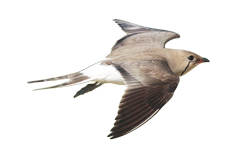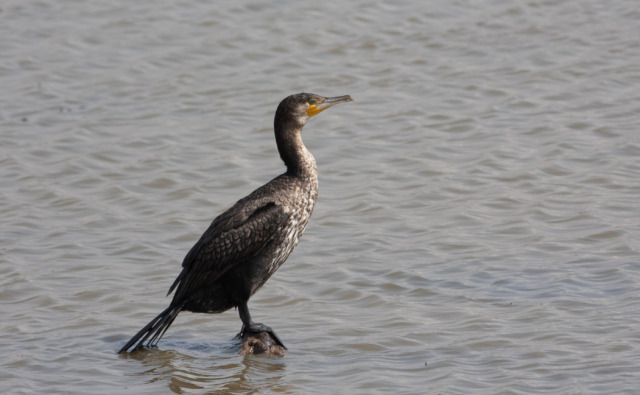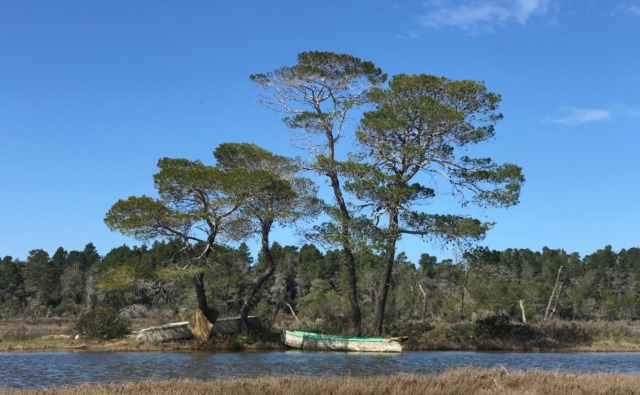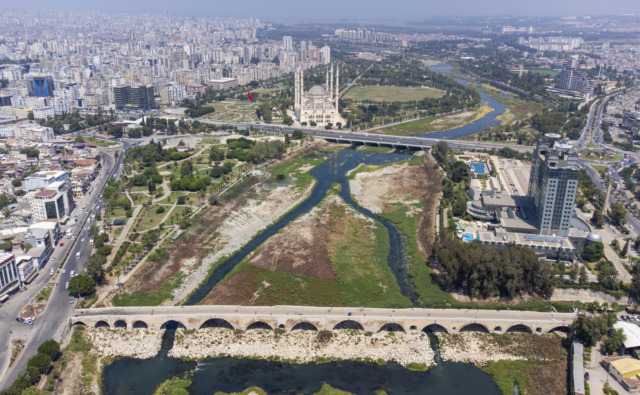Waterfowl studies in the Camargue
Objectives of the project
The bird censuses carried out in the Camargue by the Tour du Valat since it was founded in 1954 have enabled the identification and preservation of the important zones for conserving waterbirds, and also to measure the conservation status of species in the framework of the Agreement on the Conservation of African-Eurasian Migratory Waterbirds (AEWA) and to assess the implementation of the European Birds Directive. The aerial and ground counts conducted in the Camargue also bring together the various stakeholders concerned by the issue.
There are particular objectives for certain waterfowl species (ducks), with research work carried out in collaboration with the National Office for Hunting and Wildlife (ONCFS) on the consequences of releasing Mallard, use of rice fields by ducks, and causes of the decline of the Common Pochard in Europe.
Actions and methodology
The first aerial censuses of wintering waterfowl in the Camargue were initiated by Luc Hoffmann in 1955, with the aim of continuing them in order to analyse long-term demographic trends. Based on a standardised protocol, the censuses were carried out by Alain Tamisier, a researcher from the French National Research Centre (CNRS), from 1964 to 2002. Between 2004 and 2013, it was Michel Gauthier-Clerc, a researcher from the Tour du Valat, who took over the monitoring. Since 2014, the aerial surveys have been performed by Jean-Baptiste Mouronval from the ONCFS, currently project manager at the Federation for the Protection and Management of the Camargue in the Gard (SMCG). The censuses are co-funded by the ONCFS, the Tour du Valat, and the SMCG.
Results
The annual meeting held in the spring at the Tour du Valat is open to anyone interested in the studies carried out on waterbirds or hunting in the Camargue. An overall assessment of the winter bird counts is presented, as well as the ONCFS and the Tour du Valat studies.
Team
- Project leader: Jocelyn Champagnon
- Date of project: Since 2004
Technical and financial partners
- Le Vigueirat Marshes
- CEFE-CNRS
- Salins Group
- Bouches-du-Rhône Departmental Council
- Bouches-du-Rhône Departmental Hunting Federation
- Fondation François Sommer
- Gard Departmental Hunting Federation
- French Office for Biodiversity (OFB)
- Camargue Regional Natural Park
- Pont de Gau Ornithology Park
- Camargue National Nature Reserve / National Nature Protection Society (SNPN)
- Federation for the Protection and Management of the Camargue in the Gard (SMCG)
Publications
Bird counts
- Vallecillo D. 2021. Modélisation de la répartition spatio-temporelle des oiseaux d’eau en Camargue – un outil pour la gestion. [Thèse d’état sous la direction Matthieu Guillemain, Office Français de la Biodiversité et Jocelyn Champagnon, Institut de recherche pour la conservation des zones humides Tour du Valat. École Doctorale GAIA (N°584). Université de Montpellier. 250 p. https://tourduvalat.centredoc.fr/index.php?lvl=notice_display&id=59668
-
, , , et al. Reliability of animal counts and implications for the interpretation of trends. Ecol Evol. 2021; 11: 2249– 2260. https://doi.org/10.1002/ece3.7191
- Guillemain M.,Vallecillo D., Grzegorczyk E., Mouronval J-B., Gauthier-Clerc M., Tamisier A., Champagnon J. Consequences of shortened hunting seasons by the Birds Directive on late winter teal Anas crecca abundance in France. Wildlife Biology, 2021(3), wlb.00845, (27 July 2021). https://doi.org/10.2981/wlb.00845
- Jacquemin A. Évaluation de la technique d’échantillonnage à distance pour le suivi des espèces grégaires : un exercice de simulation. 2021. Mémoire de Master 2, Mention Biologie Ecologie Evolution (BEE), Université d’Angers. https://tourduvalat.centredoc.fr/index.php?lvl=notice_display&id=58876
- Malevre N. Paramètres influençant la répartition des anatidés et de la Foulque macroule hivernant sur la réserve naturelle nationale de Camargue : Étude de l’influence de paramètres physico-chimiques et trophiques sur la distribution spatiale d’oiseaux d’eau hivernant 2020 Mémoire de fin d’étude pour l’obtention du diplôme Ingénieur d’AgroParisTech. https://tourduvalat.centredoc.fr/index.php?lvl=notice_display&id=57314
- Vallecillo D., Defos du Rau P., Olivier A., Champagnon J., Guillemain M., Croce N., Massez G., Petit J., Beck N., Mondain-Monval Y., Mondain-Monval Y. 2019. Expériences cynégétiques innovantes en Camargue : des pistes pour la chasse au gibier d’eau de demain ? Faune Sauvage 323:33–39. http://www.oncfs.gouv.fr/IMG/file/publications/revue%20faune%20sauvage/Faune-Sauvage-06-FS-323-Article-6.pdf
- Sanchez E., Gauthier-Clerc M., Vandewalle P. 2009. Un compteur averti en vaut deux: Se fier aux comptages pour établir des stratégies conservatoires? Espaces naturels:24–25.
- Tamisier A., Dehorter O. 1999. Camargue, canards et foulques. Centre Ornithologique du Gard.
Use of rice fields by ducks
- Pernollet C.A., Simpson D., Gauthier-Clerc M., Guillemain M. 2015. Rice and duck, a good combination? Identifying the incentives and triggers for joint rice farming and wild duck conservation. Agriculture, Ecosystems & Environment 214:118–132. doi: (lien vers l’article)
- Niang A., Pernollet C.A., Gauthier-Clerc M., Guillemain M. 2016. A cost-benefit analysis of rice field winter flooding for conservation purposes in Camargue, Southern France. Agriculture, Ecosystems & Environment 231:193–205. doi: 10.1016/j.agee.2016.06.018 doi: 10.1002/jwmg.21167
- Pernollet C.A., Guelmami A., Green A.J., Curcó Masip A., Dies B., Bogliani G., Tesio F., Brogi A., Gauthier-Clerc M., Guillemain M. 2015. A comparison of wintering duck numbers among European rice production areas with contrasting flooding regimes. Biological Conservation 186:214–224. doi: 10.1016/j.biocon.2015.03.019
- Pernollet C.A., Simpson D., Gauthier-Clerc M., Guillemain M. 2015. Rice and duck, a good combination? Identifying the incentives and triggers for joint rice farming and wild duck conservation. Agriculture, Ecosystems & Environment 214:118–132. doi: 10.1016/j.agee.2015.08.018
- Pernollet C.A. 2016. L’utilisation des rizières par les canards hivernants: vers une gestion en interculture favorable aux canards et aux agriculteurs. Thèse de doctorat, Université Montpellier 2.
- Pernollet C.A., Cavallo F., Simpson D., Gauthier-Clerc M., Guillemain M. 2017. Seed density and waterfowl use of rice fields in Camargue, France. The Journal of Wildlife Management 81:96–111.
- Guillemain M., Elmberg J., Pernollet C.A., Arzel C., Eadie J.M. 2017. Agent-based modeling may help to merge research traditions in foraging ecology in Europe and North America: Duck Foraging Studies in Europe vs. America. Wildlife Society Bulletin 41:170–176. doi: 10.1002/wsb.736
Consequences of releasing Mallard
- Champagnon J. 2011. Conséquences des introductions d’individus dans les populations d’oiseaux d’eau exploitées : l’exemple du canard colvert Anas platyrhynchos. Thèse de doctorat: Université Montpellier 2.
- Guillemain M., Champagnon J., Massez G., Pernollet C.A., George T., Momerency A., Simon G. 2015. Becoming more sedentary? Changes in recovery positions of Mallard Anas platyrhynchos ringed in the Camargue, France, over the last 50 years. Wildfowl 65:51–63.
- Champagnon J., Legagneux P., Souchay G., Inchausti P., Bretagnolle V., Bourguemestre F., Van Ingen L., Guillemain M. 2016. Robust estimation of survival and contribution of captive-bred Mallards Anas platyrhynchos to a wild population in a large-scale release programme. Ibis 158:343–352. doi: 10.1111/ibi.12341
- Champagnon J., Guillemain M., Mondain-Monval J.-Y., Souchay G., Legagneux P., Bretagnolle V., Van Ingen L., Bourguemestre F., Lebreton J.-D. 2016. Contribution of released captive-bred Mallards to the dynamics of the natural population. Ornis Fennica 93:3–11.
- Champagnon J., Crochet P.-A., Kreisinger J., Čížková D., Gauthier-Clerc M., Massez G., Söderquist P., Albrecht T., Guillemain M. 2013. Assessing the genetic impact of massive restocking on wild mallard. Anim Conserv 16:295–305. doi: 10.1111/j.1469-1795.2012.00600.x
- Vittecoq M., Grandhomme V., Champagnon J., Guillemain M., Crescenzo-Chaigne B., Renaud F., Thomas F., Gauthier-Clerc M., van der Werf S. 2012. High Influenza A Virus Infection Rates in Mallards Bred for Hunting in the Camargue, South of France. PLoS ONE 7:e43974. doi: 10.1371/journal.pone.0043974
- Čížková D., Javůrková V., Champagnon J., Kreisinger J. 2012. Duck’s not dead: Does restocking with captive bred individuals affect the genetic integrity of wild mallard (Anas platyrhynchos) population? Biological Conservation 152:231–240. doi: 10.1016/j.biocon.2012.04.008
- Champagnon J., Guillemain M., Elmberg J., Massez G., Cavallo F., Gauthier-Clerc M. 2012. Low survival after release into the wild: assessing “the burden of captivity” on Mallard physiology and behaviour. European Journal of Wildlife Research 58:255–267. doi: 10.1007/s10344-011-0573-3
- Champagnon J., Elmberg J., Guillemain M., Gauthier-Clerc M., Lebreton J.-D. 2012. Conspecifics can be aliens too: A review of effects of restocking practices in vertebrates. Journal for Nature Conservation 20:231–241. doi: 10.1016/j.jnc.2012.02.002
- Guillemain M., Elmberg J., Gauthier-Clerc M., Massez G., Hearn R., Champagnon J., Simon G. 2010. Wintering French Mallard and Teal are heavier and in better body condition than 30 years ago: Effects of a changing environment? AMBIO 39:170–180. doi: 10.1007/s13280-010-0020-9
- Champagnon J., Guillemain M., Elmberg J., Folkesson K., Gauthier‐Clerc M. 2010. Changes in Mallard Anas platyrhynchos bill morphology after 30 years of supplemental stocking. Bird Study 57:344–351. doi: 10.1080/00063657.2010.486028
- Champagnon J., Guillemain M., Gauthier-Clerc M., Lebreton J.-D., Elmberg J. 2009. Consequences of massive bird releases for hunting purposes: Mallard Anas platyrhynchos in the Camargue, southern France. Wildfowl Special Issue 2:184–191.
Other publications
- Folliot B., Guillemain M., Champagnon J., Caizergues A. 2019. Statut, distribution et fonctionnement démographique des populations de Fuligule milouin. Faune Sauvage 322:19–24.
- Folliot B., Guillemain M., Champagnon J., Caizergues A. 2018. Patterns of spatial distribution and migration phenology of common pochards Aythya ferina in the Western Palearctic: a ring-recoveries analysis. Wildlife Biology 2018:wlb.00427. doi: 10.2981/wlb.00427
- Guillemain M., Calenge C., Champagnon J., Hearn R. 2017. Determining the boundaries and plasticity of migratory bird flyways: a Bayesian model for Eurasian Teal Anas crecca in Western Europe. J Avian Biol:n/a-n/a. doi: 10.1111/jav.01258
- Guillemain M., Pernollet C.A., Massez G., Cavallo F., Simon G., Champagnon J. 2015. Disentangling the drivers of change in Common Teal migration phenology over 50 years: land use vs. climate change effects. Journal of Ornithology 156:647–655. doi: 10.1007/s10336-015-1171-z
- Guillemain M., Champagnon J., Gourlay-Larour M.-L., Cavallo F., Brochet A.-L., Hars J., Massez G., George T., Perroi P.-Y., Jestin V., Caizergues A. 2015. Blood and cloacal swab sampling for avian influenza monitoring has no effect on survival rates of free-ranging ducks. Ibis 157:743–753. doi: 10.1111/ibi.12280
- Guillemain M., Cavallo F., Massez G., George T., Baudet J.-P., Gonzalez P., Ducasse V., Caillot E., Lecaplain B., Tison L., Piffeteau N., Artel J.-P., Champagnon J. 2015. Ringing does not appear to have an adverse effect on body mass immediately following capture in Common Teal Anas crecca. Wildfowl 65:64–74.



